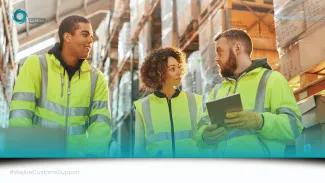In a recent webinar Rick Hendriks, Region Director South at Customs Support explained what companies could do to ensure a smooth flow of goods between the European Union and the United Kingdom. While the webinar was centred around how learnings from Brexit can make your organisation more efficient, the learnings apply to flows from the European Union to other third countries as well.
In that same webinar Gerrit Schinkel, Sales Managers Northern & Central Europe at Teleroute, explained logistics operations could be made more efficient by eliminating trucks driving home empty after delivering their load.
How to increase the efficiency of your logistics operation: digital customs
One surefire way to increase the efficiency of your inbound and outbound flow of goods is to digitize your customs processes. The digitisation of customs processes is done through interfacing with your customs broker. Benefits of interfacing are, amongst others, an increase in data quality, elimination of data entry errors, and an increase in operational efficiency.
There are several key areas you need to focus on when you interface with your customs broker. Some of the aspects Rick talked about in the webinar are:
- Compliance: have all documents and permits in place.
- Preferential Origin: be up to speed with all trade agreements that may apply
- The Complexity of Goods: know if additional requirements, like special licenses, apply.
Rick also spoke about the Customs Support onboarding process and what it takes for companies to partner with a new customs broker. He touched on subjects like screening, power of attorney, and Customs Support’s AEO certification and then explained how Customs Support has digitized and optimised its processes.
How to increase the efficiency of your logistics operation: load factor
There are many different ways to find a load for your truck or a truck for your load. One of the most efficient ones is through what is called a freight exchange, like Teleroute. Freight exchanges used to focus on spot freight, but nowadays, they are also used for contractual freight.
Looking at Brexit, several insights are essential for companies considering transporting goods from the European Union to the United Kingdom or the other way round. Some of the insights Gerrit mentioned in the webinar are:
- Check on available return loads before crossing the Channel
- Check if all documents are available. When in doubt, consult a customs broker.
- Make sure you have flexibility in your planning.
The Alpega Group (Teleroute is part of Alpega) recently looked into the main challenges of Brexit for 2021. They found that carriers see a significant impact on their business because of Brexit. Many have reduced their activity between the European Union and the United Kingdom, and one of the main reasons is the increase in the paperwork needed. This increase in paperwork can be seen as a threat or, if you have your customs processes in order, as an opportunity for growth.
Looking at the future of Logistics, Gerrit mentioned several developments: consignments will get smaller, the shortage of drivers will remain, and road congestions will increase. With so many trucks running empty, an increase in the load factor could solve many of these developments.
Collaboration is Key
During the webinar recap, Rick and Gerrit spoke about one of the game-changers in logistics in the future. Closer cooperation between parties in the supply chain could change the world logistics for the better. They both agreed that the cooperation between Customs Support and Teleroute is an excellent example of that.
There was much more information in the webinar than I could fit in this recap. Please find the full recording of the webinar here.














